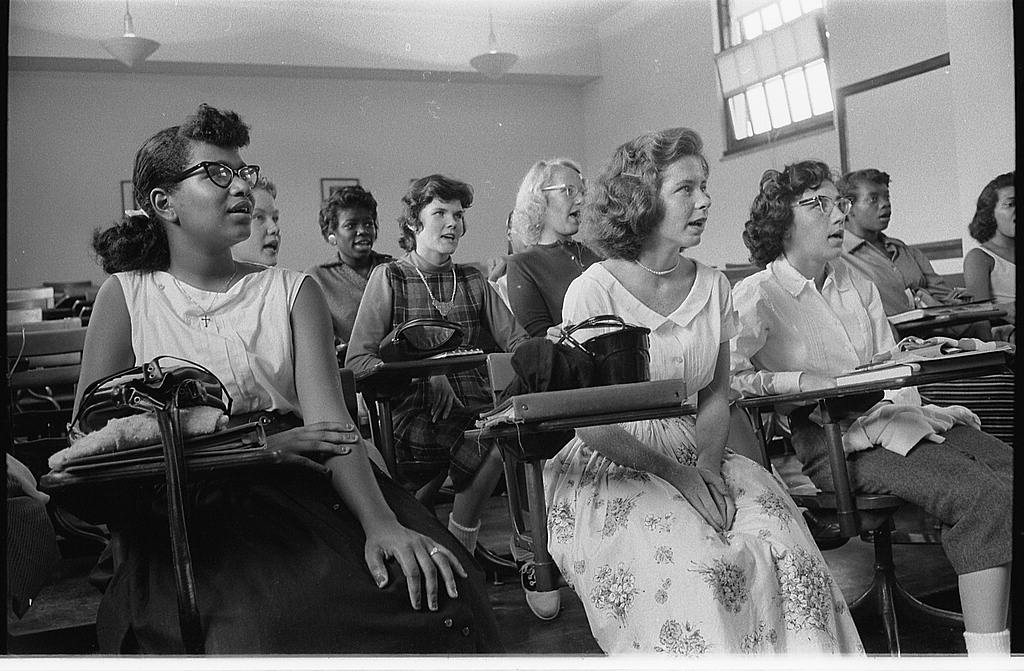Introduction: Desegregation
Students at Anacostia High School September 10, 1957, three years after the Supreme Court’s ruling in the Bolling v. Sharpe case that outlawed school segregation in the District of Columbia. Photo by Warren K. Leffler, Library of Congress.
Twenty years before the start of the Civil War and another one hundred years before the Montgomery Bus Boycott, Frederick Douglass and his friend James Buffum refused to leave a segregated train car in 1841. Their refusal inspired similar actions that, temporarily, granted equal rights for Black citizens in public accommodations. The Transportation Protests timeline offers students a range of other examples of the bravery of individuals and groups that challenged segregation in public transportation, such as Ida B. Wells, Maggie Lena Walker, Pauli Murray, Jackie Robinson, and Claudette Colvin. There are hundreds more stories in Traveling Black: A Story of Race and Resistance by Mia Bay. Meanwhile, students learn about Rosa Parks and possibly Claudette Colvin in 1955, as if they were the first and only ones to challenge Jim Crow transportation.
While segregation did not occur uniformly across the United States, the denial of equal access to public accommodations had everything to do with race, ethnicity, and national origin. Public accommodations are those spaces and resources intended for all members of society, particularly for those that are supported by taxpayers. The experiences of Latinx and Hispanic communities in California, New Mexico, and other parts of the Southwest, the formation of Indian reservations, redlining and Jim Crow all demonstrate the deliberate segregation of communities of color in U.S. life. In many cases, Native, Latinx, and Asian communities were classified with Black people and excluded from so-called “white” facilities, to maintain and promote white supremacy.
Throughout U.S. history, communities of color fought for their right to equal access and for human dignity and equity. Desegregation in public schools, transportation, and other accommodations involved more than court cases and legal victories. Desegregation was a long struggle led by students, parents, and every day citizens who experienced or saw the injustice of American segregation. Faced by indignities and violence, students and parents maintained the courage to fight for the rights of first class citizenship. They were not interested in integration, or the desire to mingle socially or otherwise with whites, but to break and reconstruct institutions that forced people of color into positions of poverty, illiteracy, and political powerlessness.
Before the Brown v. Board of Education decision in 1954, the Lemon Grove case in 1930 and 1947 Mendez v. Westminster School District case challenged segregation in education. The Mendez case was brought by Mexican-American and Puerto Rican farmers Gonzalo and Felicitas Mendez, who were unwilling to accept second-class citizenship for themselves and their children. Scholarship on Native American history, such as Denise E. Bates’ book, The Other Movement: Indian Rights and Civil Rights in the Deep South, has brought to light the political mobilization of Native American communities and the role of intertribal state commissions in the U.S. South after World War II.
By the 1940s, Black students and young people were at the forefront of early desegregation efforts. Both Rebecca de Schweinitz’s, If We Could Change the World: Young People and America's Long Struggle for Racial Equality, and Thomas Bynum’s NAACP Youth and the Fight for Black Freedom, 1936-1965 show how students during and after World War II committed themselves to challenging segregation in transportation, education, and other public spaces.
Even before the 20th century, as David Adams shows in Education for Extinction: American Indians and the Boarding School Experience, 1875-1928, Native American students pushed back against government schools through acts of resistance. Despite taunts and violence, young people, from Native American students in Pennsylvania to secondary students in Little Rock to college students across the United States, showed courage and bravery to desegregate education and public places and demand equal education.
In this section, we provide resources to explore the long history of segregation in the United States, how communities fought for their right to equal accommodations, and raise questions about the persistence of segregation and inequality in the United States today. The success of early desegregation was undermined by court decisions in the 1970s and 1980s. James Patterson in his book Brown v. Board of Education: A Civil Rights Milestone and Its Troubled Legacy shows how later court decisions limited the impact of the initial Brown decision.
As Charles J. Ogletree has noted in All Deliberate Speed: Reflections on the First Half-Century of Brown v. Board of Education, segregation “is still with us” and the goal of racial equity in education continues to elude us.

